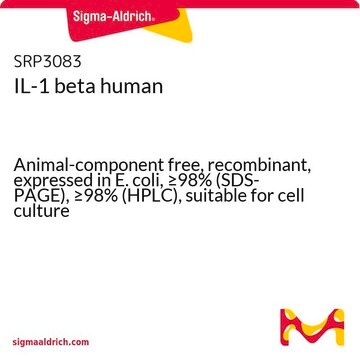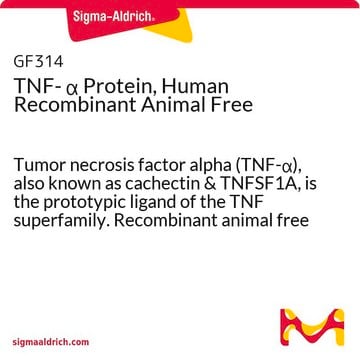T2824
Monoclonal Anti-Tumor Necrosis Factor-α antibody produced in hamster
~2 mg/mL, clone TN3-19.12, purified immunoglobulin, buffered aqueous solution
Sinónimos:
Anti-TNF-α
About This Item
Productos recomendados
origen biológico
hamster
Nivel de calidad
conjugado
unconjugated
forma del anticuerpo
purified immunoglobulin
tipo de anticuerpo
primary antibodies
clon
TN3-19.12, monoclonal
formulario
buffered aqueous solution
reactividad de especies
rat, mouse
envase
antibody small pack of 25 μL
concentración
~2 mg/mL
técnicas
immunoprecipitation (IP): suitable
indirect ELISA: suitable
microarray: suitable
neutralization: suitable
western blot: 0.25-0.5 μg/mL using recombinant mouse TNF-α
Nº de acceso UniProt
Condiciones de envío
dry ice
temp. de almacenamiento
−20°C
modificación del objetivo postraduccional
unmodified
Información sobre el gen
mouse ... Tnf(21926)
rat ... Tnf(24835)
Descripción general
Especificidad
Inmunógeno
Aplicación
- immunoblotting
- enzyme-linked immunosorbent assay (ELISA)
- immunoprecipitation
- neutralization
Acciones bioquímicas o fisiológicas
Forma física
Cláusula de descargo de responsabilidad
Not finding the right product?
Try our Herramienta de selección de productos.
Código de clase de almacenamiento
10 - Combustible liquids
Clase de riesgo para el agua (WGK)
WGK 3
Punto de inflamabilidad (°F)
Not applicable
Punto de inflamabilidad (°C)
Not applicable
Certificados de análisis (COA)
Busque Certificados de análisis (COA) introduciendo el número de lote del producto. Los números de lote se encuentran en la etiqueta del producto después de las palabras «Lot» o «Batch»
¿Ya tiene este producto?
Encuentre la documentación para los productos que ha comprado recientemente en la Biblioteca de documentos.
Nuestro equipo de científicos tiene experiencia en todas las áreas de investigación: Ciencias de la vida, Ciencia de los materiales, Síntesis química, Cromatografía, Analítica y muchas otras.
Póngase en contacto con el Servicio técnico






